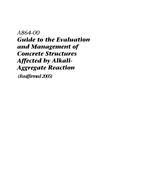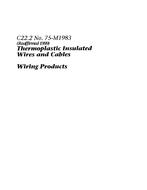Click here to purchase
1. Scope
1.1
General This Special Publication provides a method for conducting a Life Cycle Review (LCR), a less detailed and more qualitative alternative to a Life Cycle Assessment (LCA). It is primarily intended to assist small and medium-sized businesses in reviewing the various stages of the life cycle of a product, package, process, or activity (hereafter referred to collectiv ely as a product), in order to evaluate environmental burdens and provide a basis for reducing these burdens.
Like an LCA, an LCR consists of four phases: (a) Initiation Phase: Getting Started (goal definition, scoping, and screening); (b) Inventory Phase: Gathering Information and Data (development of an inventory of energy, water, and materials consumption, and of environmental releases); (c) Impact Assessment: Interpreting the Results of the Inventory Phase (assessment of the environmental impacts associated with the inputs and outputs identified in the Inventory Phase); and (d) Improvement Assessment: Reducing Environmental Impacts (ev aluation of possible environmental improvements).
Figure 1 outlines the relationship between the phases of an LCR. Note that both LCA and LCR are iterative processes, as is indicated by the feedback loops in Figure 1.
For small and medium-sized businesses, the potential benefits of an LCR are significant. Above all, an LCR can help identify opportunities for product improvement; opportunities that combine better product performance, reduced costs, and lower environmental impacts. In a competitive marketplace, quality products with improved environmental performance can provide a marketing edge.
An LCR can also help identify environmental problems that may be associated with a product, allowing a business to make changes before these problems become a public liability. Undertaking an LCR and acting on the results is, moreover, a demonstration of product stewardship – a responsible approach that should be a positive factor in both employee and customer relations.
1.2
Applicability This Special Publication is intended to assist in the conduct of LCRs that will be used to support (a) decision making with respect to the environmental performance of products, processes, or activities; (b) optimization and reduction of resource consumption (materials, energy, etc); (c) reduction of overall wastes and other emissions produced; (d) identification of alternative materials or processes which have a reduced impact on the environment; (e) provision of a basis for internal product/process comparison; and (f) communication between technical practitioners and nontechnical users of LCA.
This Special Publication is not intended to assist in the c onduct of LCRs that will be used to support external comparisons between competing products for marketing purposes.
1.3
Relationship Between LCA and LCR LCR differs from LCA in the following principal respects: (a) Screening of environmental burdens: In LCR, the Initiation Phase includes an explicit screening component, in which environmental burdens known to be of limited significance are eliminated from further considerations (see Clause 3.5). (b) Use of qualitative information: In the Inventory Phase of an LCR, qualitative information is used where reliable quantitative in formation is not readily available. Often, the most detailed quantitative information available relates to the stage of the product life cycle directly controlled by the organization commissionin g the LCR; for other stages of the product life cycle, a greater reliance on qualitative information is appropriate (see Clause 4). (c) Simplified Impact and Improvement Assessments: In LCR, the Impact and Improvement Phases include use of general guidelines, “”rules of thumb””, and simplified approaches (see Clauses 5 and 6).
The Nautilus Shell of Figure 2 shows the relationship between LCA and LCR. Following the centre nautilus from the Initiation Phase to the Improvement Assessment describes the more qualitative LCR. The arrows which form the outer nautilus describe the quantitative LCA approach. The data intensity (ie, the amount and quality of data) increases from the centre outwards.
Note that an LCR can also lead to the conduct of a full LCA. If, for instance, an LCR of a particular product provides insufficient guidance due to significant information gaps or conflicting data, further investigation in the form of an LCA may be warranted. Such an LCA would build on the LCR framework, potentially concentrating only on those areas where the most uncertainty exists, or where the most significant impacts have been found.
1.4
Defined Terms Definitions of selected terms are provided in Appendix B. Terms introduced for the first time in the text are in bold type.
1.5
SI (Metric) Units The values given in SI (metric) units are the standard. The values in pa rentheses are for information only.
Product Details
- Published:
- 02/11/2000
- Number of Pages:
- 48
- File Size:
- 1 file , 3.5 MB


